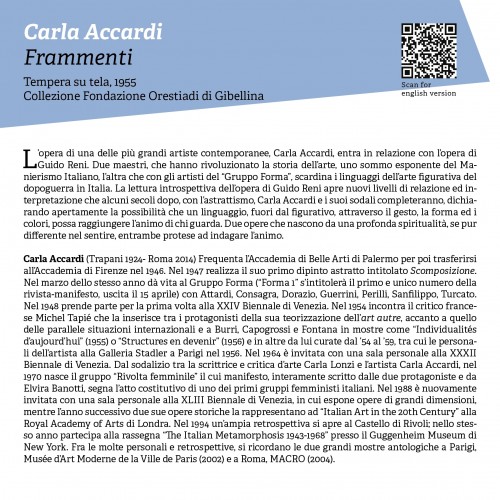Shards
Tempera on canvas, 1955
Collection of the Orestiadi Foundation of Gibellina
The artwork of one of the greatestcontemporaryartists, Carla Accardi, isdeeplyrelated to the body of art of Guido Reni. Two masters of theircraftwhorevolutionized art history, one of thembeing a veryprominent figure of ItalianMannerism and the other, with the artists of the "Gruppo Forma", redefining the language of figurative art in the post-war Italy. The introspectiveinterpretation of Guido Reni's work of art opens new levels of connection and interpretationthat after a fewcenturies, throughabstractism, Carla Accardi and hercolleagueswill make whole, openlydeclaring the possibilitythat a language, outside of the figurative and through the gesture, the shape and the colors, couldreach the soul of the beholder. Two works of art born from a deep spirituality, thoughdifferent in the feel, bothaimingatinvestigatingone's soul.
Carla Accardi (Trapani 1924-Roma 2014) SheattendedPalermo's Fine Arts Academy and thenenrolledat the Academy of Florence in 1946. In 1947 shecreatedher first abstract painting, called "Scomposizione". In the sameyearshewould go on to create the Gruppo Forma (the first and onlynumber of their magazine-manifesto wasnamed "Forma 1") with Attardi, Consagra, Dorazio, Guerrini, Perilli, Sanfilippo and Turcato. Sheparticipated for the first time at the XXIV Venice Biennale in 1948. In 1954 shemet the french critic Michel Tapié, whocommendsheras one of the protagonists of histheorization of art autre, amongthose of the parallel international scenes, and shows her artworks, together with Burri, Capogrossi, and Fontana in exhibits like "Individualités d'aujourd'hui" (1955) or "Structures en devenir" (1956) and in otherones he curatedbetween 1954 an 1959, like his personal exhibitat the Stadler Gallery in Paris in 1956. In 1964 sheisoffered a personal hall at the XXXII Venice Biennale. From the collaborationbetween the writer and art critic Carla Lonzi and the artist Carla Accardi, the group "Rivolta Femminile" isborn in 1970 and whose manifesto, entirelywritten by the twoprotagonists and Elvira Banotti, marks the creation of one of the first italianfeminist groups. In 1988 sheis once againinvited with a personal hall to the XLIII Venice Biennale, and the nextyeartwo of herhistoric works representher in "Italian Art in the 20th Century" at the Royal Academy of Arts in London. In 1994 a retrospective on herisopened to the public at the Rivoli Castle; in the sameyearshe takes part at the exhibition "The ItalianMetamorphosis 1943-1968" at the Guggenheim Museum in New York. Amonghervarious personal exhibits and retrospectives, the mostmemorables are the twoanthologies in Paris, Musée d'Art Moderne de la Ville de Paris (2002) and in Rome, MACRO (2004).
